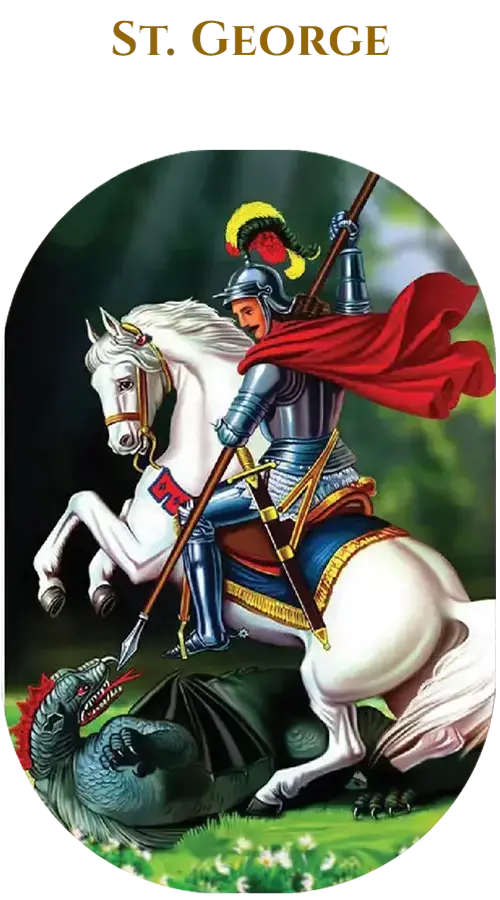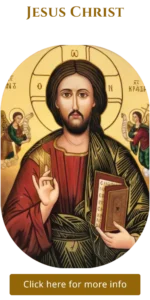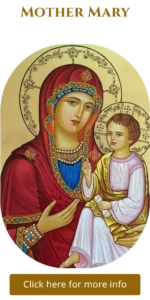Windows
- image from Mr.Salvis
Inside Paintings - East Altar
Orthodox image of St.George

Introduction
In the Syrian Orthodox tradition, St. George (Syriac: Mar Gewargis) is one of the most venerated saints, celebrated as a martyr, dragon-slayer, and protector of the faithful. The Malabar Independent Syrian Church (MISC), which follows the West Syriac Rite and shares theological and liturgical roots with the Syrian Orthodox Church, holds St. George in high esteem, as evidenced by the dedication of its cathedral, St. George’s Cathedral in Thozhiyur.


Iconography of St. George in the Syrian Orthodox Tradition
• Theological and Historical Significance: St. George, a 3rd-century Roman soldier and martyr, is revered for his unwavering faith and martyrdom under Emperor Diocletian. In Syrian Orthodox tradition, he is a model of courage, piety, and divine protection. The legend of St. George slaying the dragon, while symbolic, represents the triumph of good over evil and Christ’s victory over Satan. This imagery resonates deeply in the MISC, where St. George is a patron saint, particularly at the cathedral renovated under Joseph Mar Koorilose IX in 1989.
• Common Depictions:
– St. George the Dragon-Slayer: The most iconic image shows St. George on horseback, thrusting a lance into a dragon or serpent beneath him. The dragon symbolizes evil or Satan, and St. George’s victory represents spiritual triumph. He is often depicted in Roman military attire, wearing a red cape (symbolizing martyrdom) and armor, with a halo signifying his sainthood.
– St. George as Martyr: In some icons, St. George is portrayed standing, holding a cross or palm branch (symbols of martyrdom) and a shield, with a serene expression reflecting his faith. He may be dressed in military garb or a robe, with Syriac inscriptions identifying him as Mar Gewargis
– St. George with Christ or the Theotokos: In certain icons, St. George is depicted alongside Jesus Christ or the Virgin Mary (Mart Maryam), emphasizing his role as a servant of Christ and protector of the faithful
• Artistic Style:
– Byzantine Influence: Syrian Orthodox icons of St. George follow Byzantine conventions, with stylized, non-naturalistic forms, elongated figures, and large, expressive eyes to convey spiritual depth. The background is often gold, symbolizing divine light.
– Syriac Elements: Icons may include Syriac inscriptions, such as Mar Gewargis or prayers, and vibrant colours like red, gold, and blue. The dragon is typically depicted as a serpent-like creature, distinct from Western dragon imagery.
– Materials: Icons are traditionally painted on wood, sometimes adorned with silver or gold, and placed in churches, altars, or homes for veneration.
Liturgical and Devotional Role
• Feast Days: In the Syrian Orthodox Church and the MISC, St. George is commemorated on April 23 (his martyrdom) and other local feasts. The MISC likely holds special services at St. George’s Cathedral in Thozhiyur, with the Holy Qurbana and hymns honoring the saint. Additional feasts may include the consecration anniversaries of churches named after him, such as the cathedral’s dedication on 16 April 1989 or the Chennai church on 11 January 1981.
• Liturgical Hymns: The Fenqitho (liturgical book) contains hymns (qole) dedicated to St. George, praising his martyrdom and intercessory power. These are sung during his feast and other services, with prayers like “O Mar Gewargis, intercede for us” invoking his protection. The MISC’s West Syriac Rite incorporates these hymns, especially in parishes like Thozhiyur and Chennai.
• Devotional Practices: Devotees venerate St. George’s icons by bowing, kissing, or lighting lamps before them, seeking his intercession for protection, courage, and deliverance from evil. In the MISC, such practices are evident during feasts and at churches named after him, such as St. George’s Chapel at Karikkad, established under Paulose Mar Philoxenos III.
Role in the MISC Context
St. George holds a special place in the MISC, as evidenced by the naming of its central church, St. George’s Cathedral in Thozhiyur, and other institutions like St. George’s High School, St. George Seminary. Specific connections include:
• St. George’s Cathedral: Renovated under Joseph Mar Koorilose IX (dedicated on 16 April 1989), the cathedral likely features prominent icons of St. George, possibly as the dragon-slayer or martyr, displayed in the sanctuary (madbho). These icons serve as focal points during the Holy Qurbana and feast days.
• St. George’s Church in Chennai: Consecrated on 11 January 1981 under Mathews Mar Koorilose VIII with funding from philanthropist Sri John Peter, founder of Sheenlac paints, this church extends the MISC’s presence beyond Kerala and houses icons of St. George, reflecting his role as a protector of the diaspora community.
• St. George’s High School: Established under Geevarghese Mar Koorilose VIII in 1952, this institution reflects the saint’s association with education and community welfare, a value continued by successive Metropolitans like Cyril Mar Baselios I.
• 250th Anniversary (2022): During the MISC’s 250th anniversary celebration, presided over by Cyril Mar Baselios I, St. George’s prominence as the cathedral’s patron likely featured in liturgical events, with icons and hymns honoring him.
• St. George Seminary: Consecrated on 7 September 2025 under Cyril Mar Baselios I in Bangalore, with funding from Sri Sudhir Peter, son of Sri John Peter, Sheenlac Paints and houses icons of St. George, reflecting his role as a protector of the diaspora community.
• Gospel Association: The MISC’s Gospel Association, supported by Cyril Mar Baselios I, organizes retreats and conventions where St. George’s intercession is invoked, often through prayers and veneration of his icons, reinforcing his role as a spiritual protector.
Theological and Cultural Significance
• Symbol of Triumph: St. George’s dragon-slaying imagery resonates in the Syrian Orthodox tradition as a metaphor for Christ’s victory over sin and death, aligning with the MISC’s Christ-centered theology. His martyrdom underscores the call to steadfast faith, a theme emphasized in the MISC’s small but resilient community.
• Ecumenical Context: The MISC’s ecumenical engagements, as seen in the tenures of Joseph Mar Koorilose IX and Cyril Mar Baselios I (e.g., visits to Anglican churches and participation in the Lambeth Conference), may include shared veneration of St. George, who is also revered in Anglican and other Christian traditions. His icons likely featured in joint services, bridging Orthodox and Western traditions.
• Cultural Resonance: In Kerala’s Saint Thomas Christian community, St. George is a beloved figure, with his feast drawing processions, offerings, and communal prayers. The MISC’s churches, such as those in Thozhiyur, Kunnamkulam, and Chennai, are centers for such devotion, with icons adorned with flowers and lamps during his feast.



